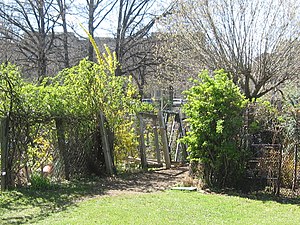
Victory gardenW is a term for growing food in local gardens, to create resilienceW and to reduce resource useW. The term originates in wartime - they were also called war gardens or food gardens for defense, and were vegetableW, fruitW and herbW gardensW planted at private residences in the United StatesW, CanadaW, United KingdomW and AustraliaW[1] during World War I and World War II to reduce the pressure on the public food supply brought on by the war effort.
The current need for sustainability, the energy/changeW crises, and continued hungerW around the world, call for similarly concerted efforts to produce food locally, and make better use of available land.
A grassroots campaign promoting such gardens has recently sprung up in the form of new Victory Gardens in public spaces, Victory Garden websites and blogs, as well as petitions to both renew a national campaign for the Victory Garden and to encourage the re-establishment of a Victory Garden on the White House lawn.
Historical "victory gardens"[edit | edit source]
In addition to indirectly aiding the war effort these gardens were also considered a civil "morale booster" - in that gardeners could feel empowered by their contribution of labor and rewarded by the produce grown. Making victory gardens became a part of daily life in the middle of the earth, the home front.
Background[edit | edit source]
Amid regular rationing of canned food in Britain, a poster campaign ("Plant more in '44!") encouraged the planting of Victory Gardens by nearly 20 million Americans. These gardens produced up to 40 percent of all the vegetable produce being consumed nationally.[verification needed]
It was emphasized to urbanWites and suburbanitesW that the produce from their gardens would help to lower the price of vegetables needed by the US War DepartmentW to feed the troops, thus saving money that could be spent elsewhere on the military: "Our food is fighting," one poster read [verification needed].
Although at first the United States Department of AgricultureW objected to Eleanor Roosevelt'sW institution of a Victory Garden on the White House grounds, fearing that such a movement would hurt the food industryW,[2] basic information about gardening appeared in public services booklets distributed by the Department of Agriculture, as well as by agribusinessW corporations such as International HarvesterW and Beech-Nut.W
Victory gardens were planted in backyards and on apartment-building rooftops, with the occasional vacant lot "commandeered for the war effort!" and put to use as a cornfield or a squash patch. During World War II, sections of lawn were publicly plowed for plots in Hyde Park, LondonW to publicize the movement. In New York CityW, the lawns around vacant "Riverside"W were devoted to victory gardens, as were portions of San FranciscoW's Golden Gate Park.W
In 1946, with the war over, many residents did not plant Victory Gardens in expectation of greater produce availability. However, shortages remained in the United Kingdom.
The Fenway Victory Gardens in the Back Bay FensW of Boston, MassachusettsW and the Dowling Community Garden in Minneapolis, MinnesotaW, remain active as the last surviving public examples from World War II. Most plots in the Fenway Victory Gardens now feature flowers instead of vegetables while the Dowling Community Garden retains its focus on vegetables.
Since the turn of the century there has existed a growing interest in Victory Gardens.
Historical images[edit | edit source]
See WWI-era U.S. victory poster and American WWII-era poster promoting victory gardens on Wikipedia.
Films[edit | edit source]
The United States Department of AgricultureW issued a 20 minute film to promote and train people how to plant victory gardens, simply titled Victory Garden.
See also[edit | edit source]
- Local food productionW
- Urban agricultureW
- PermacultureW
- Lazy gardeningW
- Intensive croppingW
- Global Food Swadeshi ProjectW
- CompostingW
Notes[edit | edit source]
- ↑ Victory gardens Australian War Memorial encylopedia
- ↑ http://www.nytimes.com/2008/10/12/magazine/12policy-t.html
External links[edit | edit source]
- Wikipedia:Rationing in the United Kingdom during and after World War II
- Wikipedia:Allotment (gardening)
- Wikipedia:Victory garden
- Wikipedia:Community garden* PBS: The Victory Garden
- A history of Victory Gardening
- Victory Gardens Handbook of the Victory Garden Committee War Services, Pennslvania State Council of Defense (April 1944)
- Victory Garden complete film at archive.org
- History of Urban Gardening in the United States